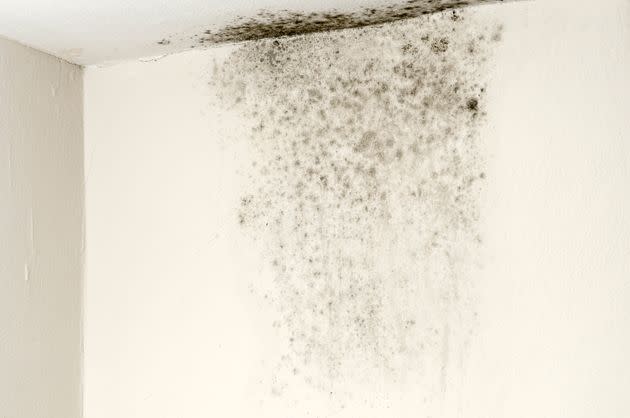This Is How Mould Can Impact Your Health – And What You Need To Do About It

In 2020, two-year-old Awaab Ishak died due to prolonged exposure to mould in the housing association flat he shared with his family in Rochdale. The recent coroner’s ruling on this tragic case has renewed anger about Britain’s housing crisis, especially as levelling up secretary Michael Gove has now admitted that “at least” tens of thousands of homes in the UK may be unsafe to live in.
“We know there are a significant number of properties – some of which were built in the 60s and 70s and are in poor conditions, but some of which have been poorly maintained – that simply need to be properly repaired and properly maintained,” he said.
Condensation is the leading cause of mould in homes across the UK, but poorly maintained buildings and heating systems exacerbate its spread. If you’re concerned about moisture in your home, here’s what you need to know.
What causes mould?
Mould is a term referring to a class of microscopic, multicellular organisms that are found in association with water, which is why you commonly find mould in your bathroom.
Dr Cameron Jones, CEO of Biological Health Services, previously told HuffPost that mould can grow anywhere where there is available water, the right temperature and a food source.
“You’ll commonly find them in bathrooms that have inadequate ventilation, ground floor apartments with poor insulation resistance which show condensation and following unexpected water from leaking roofs, a plumbing defect, or from dilapidation of buildings,” Dr Jones said.
“Any building material that can become damp, and similarly any non-porous surface like tiles and grout which become damp regularly can provide the right adhesion for the mould to grow.”

How can mould affect your health?
Moulds produce allergens (substances that can cause an allergic reaction), irritants and, sometimes, toxic substances, explains the NHS.
“Inhaling or touching mould spores may cause an allergic reaction, such as sneezing, a runny nose, red eyes and skin rash,” it adds. “Moulds can also cause asthma attacks.”
Certain people may be more sensitive to mould, including babies and children, older people, people with respiratory problems (including asthma), those with skin conditions (such as atopic eczema), and people who have a weakened immune system, for example, due to immunosuppressant medication or chemotherapy.
Condensation damp encourages the spread of two of the most common types of household mould: Cladosporium and Penicillium. Both of these can trigger allergic reactions and longterm exposure increases the risk.
Another type of mould you’ll probably be aware of is Stachybotrys, more commonly known as “black mould”.
“Stachybotrys sometimes produces toxic chemicals in its airborne spores and fungus fragments. Even though it is often called “Black mould” it may, in fact, also be green,” explains Dr Quinton Fivelman, chief scientific officer at the London Medical Laboratory.
Exposure to so-called black mould is known to cause:
coughing
dry skin that may look scaly
itchy eyes, nose and throat
a stuffy or runny nose
sneezing
trouble breathing
watery eyes
“Clearly, while it is infants and the elderly who are most vulnerable to severe complications from contact with fungi, people who are allergic to specific moulds are also at risk,” Dr Fivelman adds.
“Many of us have never been tested for mould allergies. With more of us deciding to turn our heating down or off this winter, this could increase the incidence of mould-related health problems and allergic reactions.”
What are your rights if your rented home has mould?
Your landlord should take action against damp/mould if it’s caused by a repair problem or it’s affecting your health and safety, according to the housing charity Shelter. This includes if the property has faulty heating or ventilation systems.
However, you are expected to ventilate and heat your home properly so that damp doesn’t build up. The organisation lists the following tips for reducing moisture in your home:
cover pans when cooking
use extractor fans in kitchens and bathrooms
close internal doors when you cook or shower
leave a gap between furniture and external walls
dry clothes outdoors or use a vented tumble dryer
open bedroom windows for 5-10 minutes when you get up.
If you’re struggling to heat your home due to costs, you may be eligible for support. Citizen’s Advice has a guide for accessing help with bills.
In severe cases, there are limits to what occupants can do to counteract the spread of mould. If you’re doing all you can and the problem is clearly the property, it may be time to complain.
Shelter has a detailed guide on how to make a formal complaint to the housing ombudsman if your landlord refuses to make required home improvements. You can complain whether you’re renting through a private landlord, the council or a housing association.
Related...
Michael Gove Warns That 'Tens Of Thousands' Of UK Homes Are Not Safe To Live In
Try Being A Single Woman Finding A Home Of Her Own Right Now
Revealed: The Most And Least Affordable Places To Rent Outside London

